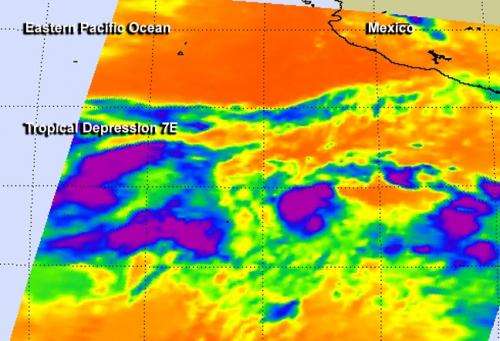A NASA infrared baby picture of Tropical Depression 7E

Tropical Depression 7E formed in the Eastern Pacific Ocean during the morning of July 30, and a NASA satellite was overhead to get an infrared baby picture. NASA's Aqua satellite passed over the depression and saw strong, but fragmented thunderstorms around the center.
The Atmospheric Infrared Sounder or AIRS instrument flies aboard NASA's Aqua satellite. AIRS creates infrared data that helps determine temperature, such as cloud top and sea surface temperatures.
AIRS captured an infrared image of Tropical Depression 7E on July 30 at 08:08 UTC/4:07 a.m. EDT. AIRS infrared data showed that the strongest storms and heaviest rains appeared in fragmented thunderstorms around the center with cloud top temperatures near -63F/-52C.
At 1500 UTC (11 a.m. EDT), newborn Tropical Depression 7E or TD7E had maximum sustained winds near 30 mph (45 kph). It was far from land and is not expected to affect any land areas as it moves farther out to sea. TD7E was centered near 12.2 north latitude and 114.9 west longitude, about 810 miles/1,300 km south-southwest of the southern tip of Baja California, Mexico. TD7E is moving to the west-northwest at 16 mph/26 kph and had a minimum central pressure of 1,008 millibars.
Forecasters at the National Hurricane Center noted in their discussion that TD7E is located in the Inter-tropical Convergence Zone or ITCZ, but has plenty of moisture and is over warm sea surface temperatures that will help it strengthen over the next couple of days.
Tropical Depression 7E is expected to move west-northwest and intensify into a tropical storm. The National Hurricane Center noted that it could later become a hurricane.
Provided by NASA's Goddard Space Flight Center




















